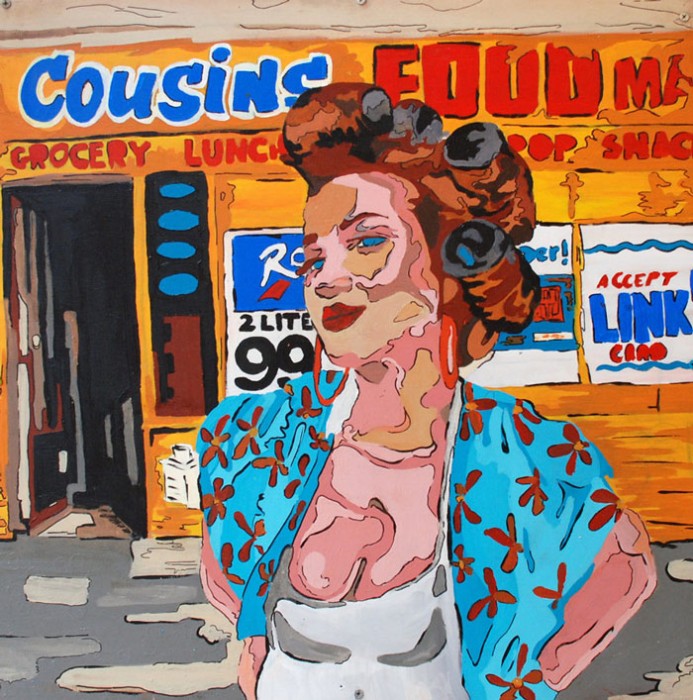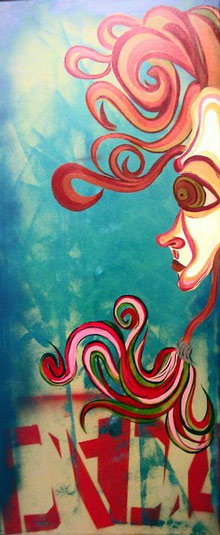Photography by Cecilia Flores
Sam Kirk is a painter, an architect, a dabbling fashion designer, culturally conscious artist and quite frankly, a badass. While her approach to artwork is as diverse as her multi-ethnic background (she’s Mexican, Puerto Rican, Irish, German and Native American), her underlying message is quite uniform—addressing issues of gentrification, community synergy and identity. With her confidence and no-rules style, Kirk’s artwork intends to question every and all aspects of reality, while highlighting characteristics that have been lost or forgotten in the people and communities she encounters every day. Her talent for combining the real with the imagined, no doubt, landed her a feature spot in last year’s Chicago Artists Month and has most recently opened a door to attend the International Arts Entrepreneurship school.
But Kirk is only getting started. Hanging out in her East Pilsen studio space, in an industrial warehouse known as the Flatlands, she tells me about the many projects she has brewing, her undying love for her cultures and the struggle to keep the cost of her artwork accessible to the audience she intends to reach.
Gozamos: How did you start off as an artist?
Sam Kirk: I’ve been painting and drawing my whole life, but I went to college to study architecture initially and my senior year I decided I didn’t want to do architecture anymore because the majority of the work that I created I was told couldn’t be built in the United States. At the time I didn’t realize that I should have just moved to Europe, because they build all that crazy shit out there. I studied the work of Antoni Gaudi a lot. His work is organic and that’s a lot of how mine was. It was about figuring out a way to not put walls up to block you in, but to put walls up to separate enough but still leave an open space. But they told me I couldn’t do that, at least not here. So I decided not to continue with architecture and went on to finish a degree in marketing. الكزينو And when I went into marketing I realized I was missing the creative part of my job, although advertising can be creative, it’s not as hands on as I needed so I started painting again. موقع العرب
The funny thing is that I do architecture now, for myself, it’s my own company. I do residential and I’m very particular about my clients. They have to be really spontaneous and can’t be afraid of extreme uses of color or me destroying their home. It’s funny that I do architecture now and that it’s my main source of income.

How do you balance painting for commission and painting for your own personal collection?
SK: Luckily, I have a couple of clients that have purchased work that I’ve sold in exhibits that really love my work and they hire me to do commissions. They tell me to go ahead and do whatever. So, that’s where I get a lot of satisfaction.
What kind of themes do you usually paint about?
SK: My personal work has a lot to do with culture and people. I’ve never been a portrait painter, I’m a little bit more abstract, more surrealism, but I have this thing about discovering different sides of people and what they are about and painting them in a way that those characteristics about them come out.
The other part of me has this strong passion for community. I guess I also have an issue with the United States, a little bit. I’ve traveled to other countries, and every other country I go to they have this really strong sense of community. They remember why things started, where they came from, why they built things and why it is the way it is. In the United States we tend to wipe it all out with franchises and let developers take over things. So a lot of my work has to do with gentrification issues and tries to bring out the highlights and the things we forget about and things in our community that make it what it is.
Is there a certain style of painting you lean towards over the other?
SK: Most painters have a certain style that people automatically recognize. I spent years trying to figure out what style I was going to have, but I’ve come to the point where I just say, I don’t fucking have one. My work usually tells stories and whether they’re personal or not is one thing. Majority of the time my work tells a story of something else. The thing about the portraits I started doing four years ago was to tell stories about ordinary people. I get off of meeting new people outside of work and knowing what they’re about. So, a lot of the portraits that I’ve painted are about those people and who they are.
Why did you choose Pilsen to have your studio? I mean you could have picked any city in the world to live in…
SK: I’ve lived in Pilsen and I’ve traveled all over the U.S., I couldn’t even tell you how many cities I’ve been in, but I haven’t found a city yet that I love as much as Chicago. There’s something about walking out of my apartment and all the colors and the people and even the drunks you hear in the morning that are passing by, or a rooster. لعبة بلاك جاك اون لاين مجانا I love that. Although Pilsen has gone through some gentrification there’s things about Pilsen that you will never see in another neighborhood. And it’s shit like the roosters.

Any projects that you’re currently working on?
SK: I have probably about four different series that I’m working on. One is a sculpture series that I’ve been trying to put together for the last two years and it’s something I’m really passionate about because it has a lot to do with my culture, one of my cultures. I’m a bunch of things. But it has to do with my Mexican culture and a lot of the issues that have been going on in society. I think once I put it out there it’s probably going to get a lot of attention. I’m really excited to finish that.
I’m also working on a couple of painting series. One is focused on the city of Chicago, its corruptness and criminal side of politics. Mostly my work has a lot to do with the stuff that is going on around me. It’s crooked and there’s always a story to tell.
With so many projects, how do you keep track of them and how do you keep from running out of ideas?
SK: As far as working on them alone, I always have to be constantly busy; that’s just who I am. I always have multiple projects going on at once so that when I have downtime I have something else to work on because otherwise I’ll just sit there and say “give me something to do.”
As far as ideas go, I have so many ideas that I wish someone could record my brain. If someone could invent a way to record my brain, I would pay any money for that because I have lost so many ideas that I haven’t written down. It’s just that my brain doesn’t stop generating ideas. It’s constant, it’s overflowing.
How accessible is your artwork?
SK: I think everyday people should be able to afford artwork and be able to have artwork, whether it’s through doing a smaller version of my painting or doing prints or something I want to always find a way to make that accessible to people. I’m big on I know where I came from, I know where my roots are, I struggled to get where I’m at. I know what it takes to work hard and get things that you really want, so I don’t want to deny people the option to have those things, including art.
I’ve had people come to my shows and they say my prices are too low and I ask says who? I don’t think they’re too low. I’m sure I can get a lot more for them but I want a certain type of people to be able to afford it and if rich people are only going to buy work that’s in the thousands and thousands of dollars and not buy work because they actually like it well I don’t want you to have mine. I’m very particular about being about that and I plan to stay that way.
To me it’s the value of art to other people than it is about the price.
To view more of Sam Kirk’s artwork visit www.iamsamkirk.com.
This is the yes and the y’all…